Conventional bulb lamps are gradually being replaced by their more economic LED counterparts. The number plate lights are no exception to this, as LED has specific advantages. Unfortunately, even new cars are rarely ever fitted with such option, although a retrofit is possible. The installation has yet certain pitfalls and the legal situation is sometimes not entirely clear.
LED number plate lights vs conventional lighting
 The light bulb has for ever been dominating the market. However, progress does not stand still and meanwhile the bulb is ready for the scrapheap. Its main successor is the LED, the Light Emitting Diode, no longer causing a thread to glow losing a lot of energy as residual heat. Instead it depends on the property of the semiconductor crystal, lighting up even with scant electricity supply and brought on the right wavelength (light colour) with help of added foreign atoms. Lesser residual heat enables a better performance, requiring lesser current for the same brightness. Traditional LEDs used in the car only require 20 milliamperes. Correspondingly low is their consumption. Instead of 10 – 20 Watt the consumption of the LEDs used for number plate lighting lies at ca. 1 Watt and often even lower. And this is with the same light yield. There are quality differences, although even cheap LEDs have a significantly longer life than conventional lighting. Quality products last up to five years without any need for replacement. The advantages at a glance:
The light bulb has for ever been dominating the market. However, progress does not stand still and meanwhile the bulb is ready for the scrapheap. Its main successor is the LED, the Light Emitting Diode, no longer causing a thread to glow losing a lot of energy as residual heat. Instead it depends on the property of the semiconductor crystal, lighting up even with scant electricity supply and brought on the right wavelength (light colour) with help of added foreign atoms. Lesser residual heat enables a better performance, requiring lesser current for the same brightness. Traditional LEDs used in the car only require 20 milliamperes. Correspondingly low is their consumption. Instead of 10 – 20 Watt the consumption of the LEDs used for number plate lighting lies at ca. 1 Watt and often even lower. And this is with the same light yield. There are quality differences, although even cheap LEDs have a significantly longer life than conventional lighting. Quality products last up to five years without any need for replacement. The advantages at a glance:
– Environment-friendly manufacture
– Lower consumption
– Adequate light yield
– Longer life span
Legal situation with LED number plate lights
 Initially, there was a separate regulation for number plate lighting. Nowadays this is subject to EU regulation, which in our country should be obeyed as well. On one hand this is a disadvantage, as others determine what is permitted here. On the other hand we can be certain that our rules apply in other European countries as well, which could be legally relevant in the case of number plate lighting.
Initially, there was a separate regulation for number plate lighting. Nowadays this is subject to EU regulation, which in our country should be obeyed as well. On one hand this is a disadvantage, as others determine what is permitted here. On the other hand we can be certain that our rules apply in other European countries as well, which could be legally relevant in the case of number plate lighting.
What generally applies: number plate lighting should be sufficiently bright but not too bright and the entire number plate surface should be lit. There are specific rules for colours and brightness. For the driver this is of minor importance. What is important: if you replace the original number plate lighting, under normal circumstances you might lose the permission to use your car, no matter if it is night or day. Having your lighting inspected by MOT would be the right move. After a short check the number plate lighting can be authorised. However, this costs money as well as time.
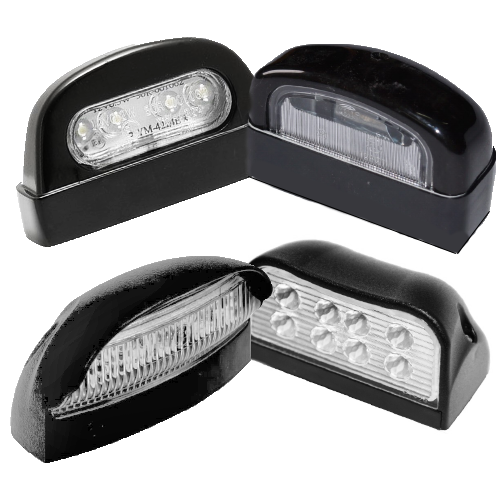
License plate lightsinexpensively up from £ 6,60To the shop ⇒ |
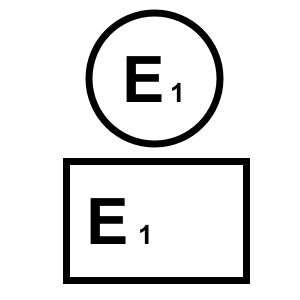 To avoid the necessity for referring to an authority, the law giver has come up with a certification guaranteeing that a car component meets the European Commission standards. This ECE certification is often abbreviated as E-certification, specifying requirements for construction. The certified product is authorised for use in combination with the corresponding car. The E-certification is printed on the package and is either a circle or a square with the letter E and a number signifying the country that has implemented the authorisation.
To avoid the necessity for referring to an authority, the law giver has come up with a certification guaranteeing that a car component meets the European Commission standards. This ECE certification is often abbreviated as E-certification, specifying requirements for construction. The certified product is authorised for use in combination with the corresponding car. The E-certification is printed on the package and is either a circle or a square with the letter E and a number signifying the country that has implemented the authorisation.
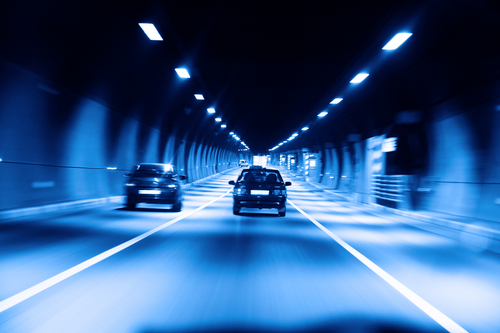 With regard to colour no experiments should be undertaken, as legibility of the number plate for passers-by as well as for cameras is imperative. There is no stipulated colour temperature, although it lies somewhere between warm white and cold white. Red, green or any other colour is prohibited. Only the daylight white, which lies in the blue colour spectrum (starting at 70000K) is permitted. If you want to be certain, check the certifications, mentioning the light’s colour temperature.
With regard to colour no experiments should be undertaken, as legibility of the number plate for passers-by as well as for cameras is imperative. There is no stipulated colour temperature, although it lies somewhere between warm white and cold white. Red, green or any other colour is prohibited. Only the daylight white, which lies in the blue colour spectrum (starting at 70000K) is permitted. If you want to be certain, check the certifications, mentioning the light’s colour temperature.
Furthermore it is important to know, that certified products are only authorised for the cars approved by the manufacturer. If you put LED number plate lights for a BMW on an AUDI, you lose the permission to use your car, even though the result may look satisfactory. Among suppliers are always black sheep, printing a slightly modified E-certification on their products, although they do not possess the necessary approval. Check carefully.
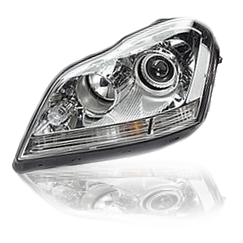
Headlights • Top priceimmediately availableBuy now ⇒ |
Step-by-step manual:
this is how replacement works
Following tools are necessary:
A screwdriver
possibly an ISO unlocking tool
or a paperclip
A cloth
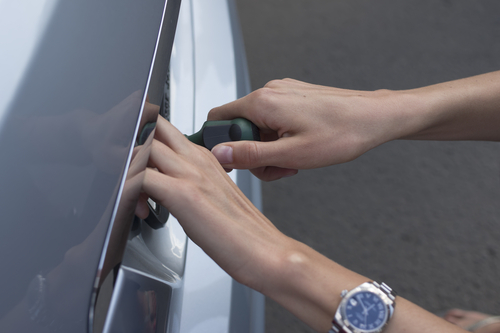 Preparation: Unscrew the number plate holder and the number plate for a better access to the attachment points for the lighting. Open the bonnet and remove the earth clamp. In older cars it is often clamped to the engine. In newer cars there is a connection with the battery (negative, black pole). This step is not absolutely necessary, though recommended as you are working with non-insulated wiring. Preparation: Unscrew the number plate holder and the number plate for a better access to the attachment points for the lighting. Open the bonnet and remove the earth clamp. In older cars it is often clamped to the engine. In newer cars there is a connection with the battery (negative, black pole). This step is not absolutely necessary, though recommended as you are working with non-insulated wiring. |
| Step 1: Most number plate lighting has a small groove on the side, from where the entire lighting can be levered out. If this is not the case, it must be unscrewed. |
| Step 2: Remove the electricity plug by taking its catch in your hand and pulling it upwards. |
| Step 3: Check in the number plate lighting’s installation manual if the polarity needs changing. If this is the case, execute the following steps. Otherwise go to step 4: – In the electricity plug is a clamp for locking the pole pins. You can manually pull it out sideways. – With the ISO unlocking tool (mostly mini-ISO), release the pin connection, turn it 180˚C and put it back again. If you don’t have this tool at hand, a straightened paperclip can be used. It can last a while before you find the right unlocking position. – Put the locking clamp back at the same side, where you removed it. |
| Step 4: Put the plug in the connection of the new LED number plate lights. Check if it is placed correctly. You should hear a click. |
| Step 5: If necessary, remove the worst dirt from the mounting holes before you insert the LED number plate lights. If your car has a clicking mechanism, you are through. Otherwise you must tighten the screws again. |
| Step 6: Put the earth clamp back on the battery. Check the entire lighting. If everything functions, the replacement was successful. |
 Possible errors and solution
Possible errors and solution
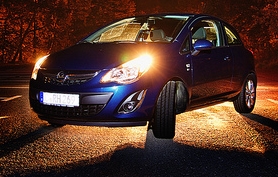 Earth fault due to cross-linking – The earth fault is a very comical phenomenon, more often occurring in older cars, meaning that due to a lacking earth connection the current generates a circuit which shouldn’t be there and places the blinkers and the number plate light in the same circuit. As a result the number plate lighting blinks or the blinker shines uninterrupted. This sounds worse than it is and can be remedied very quickly. Remove the LED lighting and apply some contact spray to the connections. Look in the fuse box and check the connections here as well. Clean possible corroded contacts or replace the fuses. Everything should work properly now.
Earth fault due to cross-linking – The earth fault is a very comical phenomenon, more often occurring in older cars, meaning that due to a lacking earth connection the current generates a circuit which shouldn’t be there and places the blinkers and the number plate light in the same circuit. As a result the number plate lighting blinks or the blinker shines uninterrupted. This sounds worse than it is and can be remedied very quickly. Remove the LED lighting and apply some contact spray to the connections. Look in the fuse box and check the connections here as well. Clean possible corroded contacts or replace the fuses. Everything should work properly now.
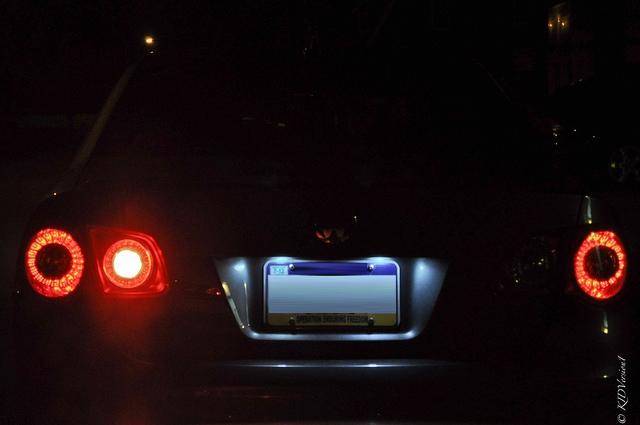 The LED number plate lights don’t work – There are several possible causes for this. Is the plug connection properly inserted, or maybe you forgot to switch the polarity insofar as this was required for assembly, or maybe you didn’t unclamp the battery, causing a short circuit, which blew the fuses. If you don’t find the solution with this guide, you have no other option but to go to a garage.
The LED number plate lights don’t work – There are several possible causes for this. Is the plug connection properly inserted, or maybe you forgot to switch the polarity insofar as this was required for assembly, or maybe you didn’t unclamp the battery, causing a short circuit, which blew the fuses. If you don’t find the solution with this guide, you have no other option but to go to a garage.
Foto: lassedesignen, Patrick Schulze, Christof Ambrosch, Kichigin, vnlit, victoras / shutterstock.com




 (12 votes, average: 3.25 out of 5)
(12 votes, average: 3.25 out of 5)







